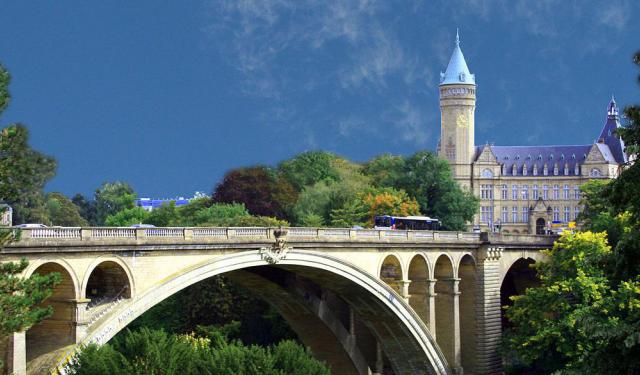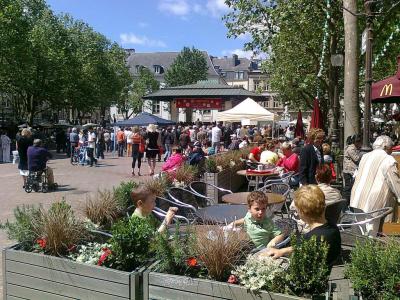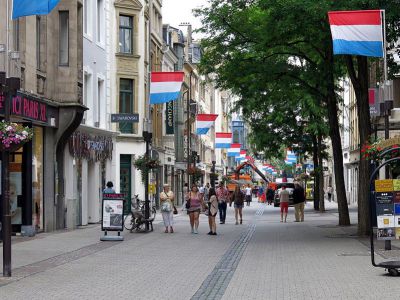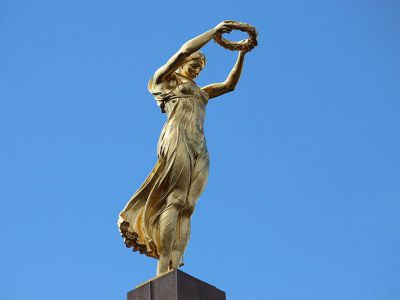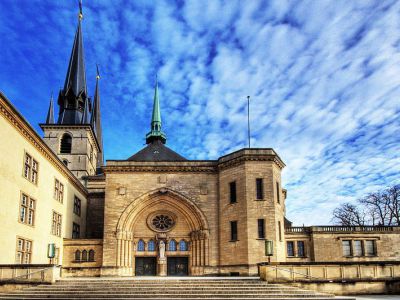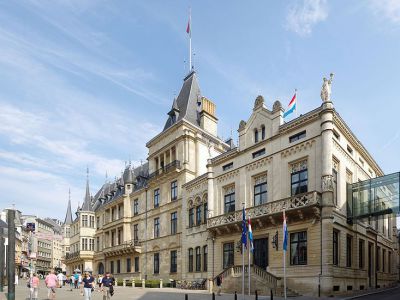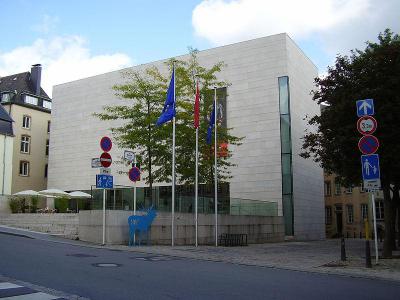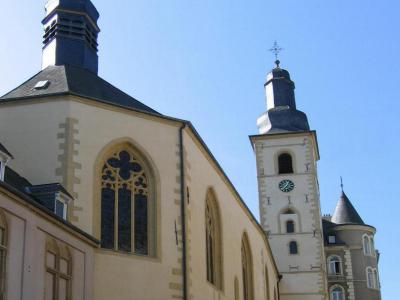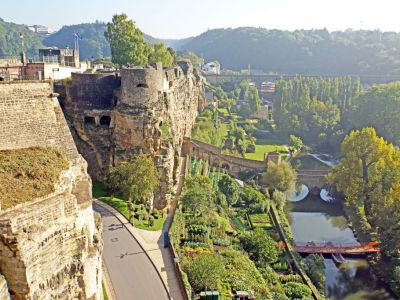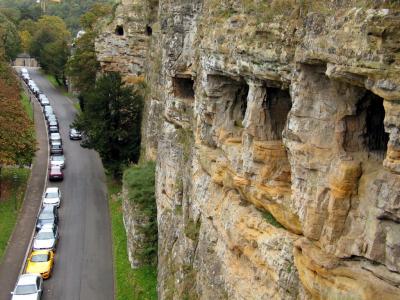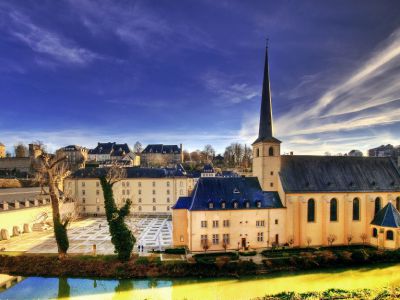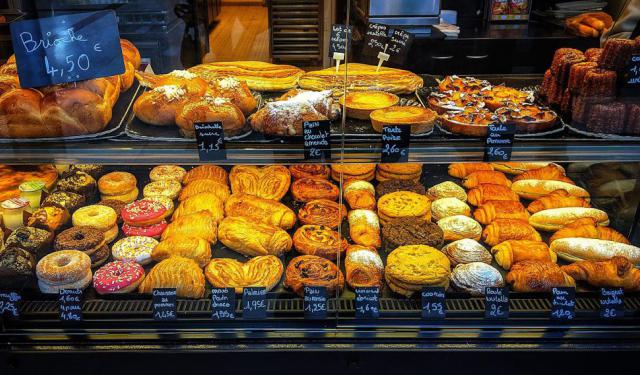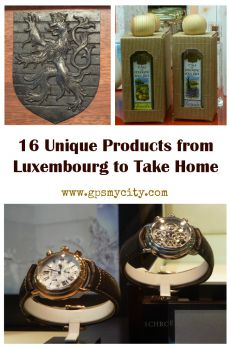Luxembourg Introduction Walking Tour (Self Guided), Luxembourg
The capital city of the Grand Duchy of Luxembourg is known as Luxembourg City. The Romans had built small forts here that guarded two roads that passed through. But it was Count Seigfried in 963 who began the town by building a castle on the Bock promontory. A small church followed on the site of present day St. Michael’s Church. Soon a community sprang up along the Roman road.
Bock Rock provided a natural spot to settle, as the elevated ground is easily defensible and surrounded on three sides by the Alzette River. Over the centuries, fortifications sprang up along the rock. As the city grew, more walls were added.
The city walls and fortifications were never breached, even though the city changed hands several times. Many of the fortifications were destroyed in the 1800s, but there are many remains to be visited. The Bock Casements and Chemin de la Corniche shouldn’t be missed, if not for the history than simply for the gorgeous views of town.
Today, Luxembourg City is one of the de facto capitals of the European Union and is filled with history. It is an easy-to-walk town, with shops and pedestrian-only streets centrally located around the Place d’Armes and Grand Rue. The Grand Ducal Palace, St. Michaels Church, and Notre Dame Cathedral are all near the city center in Ville-Haute.
There’s a lot to see and do in this flavorful European city, from fine dining, arts, and culture to historic sightseeing and relaxing in the many parks. Come on a self-guided walking tour of this beautiful capital city, and learn more about its people, places, and history.
Bock Rock provided a natural spot to settle, as the elevated ground is easily defensible and surrounded on three sides by the Alzette River. Over the centuries, fortifications sprang up along the rock. As the city grew, more walls were added.
The city walls and fortifications were never breached, even though the city changed hands several times. Many of the fortifications were destroyed in the 1800s, but there are many remains to be visited. The Bock Casements and Chemin de la Corniche shouldn’t be missed, if not for the history than simply for the gorgeous views of town.
Today, Luxembourg City is one of the de facto capitals of the European Union and is filled with history. It is an easy-to-walk town, with shops and pedestrian-only streets centrally located around the Place d’Armes and Grand Rue. The Grand Ducal Palace, St. Michaels Church, and Notre Dame Cathedral are all near the city center in Ville-Haute.
There’s a lot to see and do in this flavorful European city, from fine dining, arts, and culture to historic sightseeing and relaxing in the many parks. Come on a self-guided walking tour of this beautiful capital city, and learn more about its people, places, and history.
How it works: Download the app "GPSmyCity: Walks in 1K+ Cities" from Apple App Store or Google Play Store to your mobile phone or tablet. The app turns your mobile device into a personal tour guide and its built-in GPS navigation functions guide you from one tour stop to next. The app works offline, so no data plan is needed when traveling abroad.
Luxembourg Introduction Walking Tour Map
Guide Name: Luxembourg Introduction Walking Tour
Guide Location: Luxembourg » Luxembourg (See other walking tours in Luxembourg)
Guide Type: Self-guided Walking Tour (Sightseeing)
# of Attractions: 10
Tour Duration: 2 Hour(s)
Travel Distance: 2.1 Km or 1.3 Miles
Author: DanaOffice
Sight(s) Featured in This Guide:
Guide Location: Luxembourg » Luxembourg (See other walking tours in Luxembourg)
Guide Type: Self-guided Walking Tour (Sightseeing)
# of Attractions: 10
Tour Duration: 2 Hour(s)
Travel Distance: 2.1 Km or 1.3 Miles
Author: DanaOffice
Sight(s) Featured in This Guide:
- Place d'Armes
- Grand Rue
- Gëlle Fra (Monument of Remembrance)
- Notre-Dame Cathedral
- Grand Ducal Palace
- National Museum of History and Art
- St. Michael's Church
- Chemin de la Corniche (Walls of the Corniche)
- Bock Casemates
- Neumünster Abbey
1) Place d'Armes
The original town square of the old town is still the heart of the community. Here, you'll find locals and visitors out and about, enjoying the fresh air and sunshine during the warm summer months. Many restaurants and cafés have outdoor patios, and this whole part of town is a pedestrian-only zone. You'll often find live music or open-air markets going on.
On the square's eastern side is the Cercle, which was initially designed as an administrative building. It was the site of the European Court of Justice but is now a venue for cultural events. Outside of it, you will find a sculpture of Countess Ermisinde with the 1244 Charter of Emancipation that guaranteed citizen's rights.
On the opposite end, there are monuments dedicated to two of Luxembourg's poets, Dicks and Michel Lentz. The lion on the monument represents the Grand Duchy, and the national motto is inscribed on the pillar. It translates, "We want to stay what we are."
The square gets its name from its historical purpose of being a gathering spot and parade ground for troops. The spot was laid out after a massive fire destroyed much of Ville-Haute in 1554. Dutch military engineer Sebastian van Noyen created the first version of the square called New Market.
In 1671, Spanish engineer Jean Charles de Landas used the area as a parade spot for the garrison. Flagstones and lime trees were added under Louis XIV.
On the square's eastern side is the Cercle, which was initially designed as an administrative building. It was the site of the European Court of Justice but is now a venue for cultural events. Outside of it, you will find a sculpture of Countess Ermisinde with the 1244 Charter of Emancipation that guaranteed citizen's rights.
On the opposite end, there are monuments dedicated to two of Luxembourg's poets, Dicks and Michel Lentz. The lion on the monument represents the Grand Duchy, and the national motto is inscribed on the pillar. It translates, "We want to stay what we are."
The square gets its name from its historical purpose of being a gathering spot and parade ground for troops. The spot was laid out after a massive fire destroyed much of Ville-Haute in 1554. Dutch military engineer Sebastian van Noyen created the first version of the square called New Market.
In 1671, Spanish engineer Jean Charles de Landas used the area as a parade spot for the garrison. Flagstones and lime trees were added under Louis XIV.
2) Grand Rue
The east to west street located just north of the Place d'Armes is known as Grand Rue. As the central square, the street is for pedestrians only. Many shops and boutiques lie along this stretch of road-indeed, it is essentially an outdoor shopping complex. Everything from famous international brands to unique local artisan shops can be found here.
The shops are built on the ground floors of the buildings of this historic area of town. Many of the buildings above the shops are residential, but the entire area is a concentrated commercial zone with administrative offices, political institutions, shops, and banks. At the west end of the street, you'll find the Royal-Hamilius, a large residential and shopping mall development completed in 2019.
The east end of the street ends just a block north of the Grand Ducal Palace on Rue du Marché aux Herbes. If you continue east on Grand Rue, it will turn into Rue Sigefroi. You will arrive at the Bock promontory, where the casements, Archaeological Crypt, Chemin de la Corniche, and St. Michaels Church are located.
While Grand Rue is a great place to start, the entire center of the city, known as Ville-Haute, is a walking and shopping district. The streets and boulevards connecting Grand Rue with the rest of the town are also lined with dozens of shops and restaurants. Visit the information kiosk in the Place d'Armes for maps and directions.
The shops are built on the ground floors of the buildings of this historic area of town. Many of the buildings above the shops are residential, but the entire area is a concentrated commercial zone with administrative offices, political institutions, shops, and banks. At the west end of the street, you'll find the Royal-Hamilius, a large residential and shopping mall development completed in 2019.
The east end of the street ends just a block north of the Grand Ducal Palace on Rue du Marché aux Herbes. If you continue east on Grand Rue, it will turn into Rue Sigefroi. You will arrive at the Bock promontory, where the casements, Archaeological Crypt, Chemin de la Corniche, and St. Michaels Church are located.
While Grand Rue is a great place to start, the entire center of the city, known as Ville-Haute, is a walking and shopping district. The streets and boulevards connecting Grand Rue with the rest of the town are also lined with dozens of shops and restaurants. Visit the information kiosk in the Place d'Armes for maps and directions.
3) Gëlle Fra (Monument of Remembrance)
Luxembourgish for "Golden Lady," the Gëlle Fra is a monument located in Constitution Square. The square itself was created on an ancient Bock bastion overlooking the Pétrusse River and park in the valley below. The memorial is to the thousands of Luxembourgers who volunteered for service during the World Wars. It was built in 1923.
The centerpiece of the monument is a 21-meter tall granite obelisk. A gilded bronze statue of Nike, the goddess of victory, stands atop an obelisk.
Germany occupied Luxembourg during the First World War, so there was little that the nation's people could do to help the Allied Powers. But over 3,700 Luxembourgers living outside of the country volunteered to fight in the French army; over 2,000 of them became casualties of the war. The monument was created to honor their courage and sacrifice.
The Nazis dismantled the monument during WWII, but various pieces were recovered and restored. The Gëlle Fra statue was missing until she turned up under the national football stadium's main stands in 1980. Recent additions to the memorial have honored those who fought in World War II and the Korean War.
Immediately west of Constitution Square is the Casemates de la Pétrusse. Both are situated above the Parcs de la Pétrusse and Garden Luxembourg. Walking trails and stairways connect to the valley below, with beautiful views of the Adolphe Bridge crossing over the Pétrusse River and park.
Why You Should Visit:
You can see it from a distance but come near to experience its beauty.
The view of the city from the memorial area is even more fantastic.
Tip:
The best views of Gëlle Fra are during the Christmas market as the Ferris wheel is put up in the parking lot surrounding the statue and you can have a very close look.
The centerpiece of the monument is a 21-meter tall granite obelisk. A gilded bronze statue of Nike, the goddess of victory, stands atop an obelisk.
Germany occupied Luxembourg during the First World War, so there was little that the nation's people could do to help the Allied Powers. But over 3,700 Luxembourgers living outside of the country volunteered to fight in the French army; over 2,000 of them became casualties of the war. The monument was created to honor their courage and sacrifice.
The Nazis dismantled the monument during WWII, but various pieces were recovered and restored. The Gëlle Fra statue was missing until she turned up under the national football stadium's main stands in 1980. Recent additions to the memorial have honored those who fought in World War II and the Korean War.
Immediately west of Constitution Square is the Casemates de la Pétrusse. Both are situated above the Parcs de la Pétrusse and Garden Luxembourg. Walking trails and stairways connect to the valley below, with beautiful views of the Adolphe Bridge crossing over the Pétrusse River and park.
Why You Should Visit:
You can see it from a distance but come near to experience its beauty.
The view of the city from the memorial area is even more fantastic.
Tip:
The best views of Gëlle Fra are during the Christmas market as the Ferris wheel is put up in the parking lot surrounding the statue and you can have a very close look.
4) Notre-Dame Cathedral (must see)
Nestled in the historic quarter of Ville Haute, the Notre-Dame Cathedral is a timeless gem combining architectural elegance and spiritual depth. Originally built as a Jesuit church between 1613 and 1621, under the direction of Brother Jean du Blocq and Ulrich Job, it was granted cathedral status in 1870 and stands today as the only cathedral in the Grand Duchy. Its façade, with three distinct towers added during the 1935–38 expansion, marks a striking silhouette on the city skyline.
This sacred space delights visitors with a rich mix of late Gothic, Renaissance, and Baroque design elements-from the soaring pointed arches and cylindrical pillars to the ornate alabaster carvings and sculpted pulpit that brings biblical stories to life. Inside, the cloistered nave and choir are illuminated by masterful stained‑glass windows, crafted by artists such as Louis Barillet and Josef Oberberger, which bathe the interior in vibrant, multicolored light.
At the heart of the cathedral lies the venerated statue of Our Lady of Luxembourg-also known as “Consolatrix Afflictorum”-the nation’s patron saint. This 16th-century wooden Madonna and Child holds deep religious and patriotic significance. It is paraded through the streets during the annual Octave pilgrimage in spring, a culminating tradition that dazzles with devotion and local festivity. The crypt also contains the tombs of Luxembourg’s Grand Dukes and prominent national figures.
Admission is free, and the cathedral is conveniently open daily-typically from early morning until evening-with optional audio-guide tours available in multiple languages. Whether you're drawn by architectural grandeur, spiritual solace, or cultural heritage, Notre‑Dame Cathedral offers a powerful and memorable welcome to Luxembourg City.
Why You Should Visit:
Visitors who are interested in art or Gothic architecture will love this stop. The stained glass windows are gorgeous, even in dim light.
Tip:
Anyone considering the rooftop trip – make sure you fit, as it's a spiral staircase top to bottom with only a brief rest area in a gift shop. Fantastic view from the top, but a trek! Don't forget to also visit the crypt, which is decidedly cooler on hot days.
This sacred space delights visitors with a rich mix of late Gothic, Renaissance, and Baroque design elements-from the soaring pointed arches and cylindrical pillars to the ornate alabaster carvings and sculpted pulpit that brings biblical stories to life. Inside, the cloistered nave and choir are illuminated by masterful stained‑glass windows, crafted by artists such as Louis Barillet and Josef Oberberger, which bathe the interior in vibrant, multicolored light.
At the heart of the cathedral lies the venerated statue of Our Lady of Luxembourg-also known as “Consolatrix Afflictorum”-the nation’s patron saint. This 16th-century wooden Madonna and Child holds deep religious and patriotic significance. It is paraded through the streets during the annual Octave pilgrimage in spring, a culminating tradition that dazzles with devotion and local festivity. The crypt also contains the tombs of Luxembourg’s Grand Dukes and prominent national figures.
Admission is free, and the cathedral is conveniently open daily-typically from early morning until evening-with optional audio-guide tours available in multiple languages. Whether you're drawn by architectural grandeur, spiritual solace, or cultural heritage, Notre‑Dame Cathedral offers a powerful and memorable welcome to Luxembourg City.
Why You Should Visit:
Visitors who are interested in art or Gothic architecture will love this stop. The stained glass windows are gorgeous, even in dim light.
Tip:
Anyone considering the rooftop trip – make sure you fit, as it's a spiral staircase top to bottom with only a brief rest area in a gift shop. Fantastic view from the top, but a trek! Don't forget to also visit the crypt, which is decidedly cooler on hot days.
5) Grand Ducal Palace (must see)
Nestled in the heart of Luxembourg City’s medieval Old Town, the Grand Ducal Palace is a striking example of Flemish Renaissance architecture that has served as the official seat of Luxembourg’s monarchy since 1890. Originally built as the city hall in 1572–1573 on the ruins of an earlier 1418 structure, the palace evolved from municipal government offices to the residence and workplace of the Grand Duke and his family.
Inside, the first floor of the palace boasts lavishly decorated state rooms such as the grand staircase, reception halls, dining rooms, and the Salon des Rois, where the Grand Duke hosts official events and welcomes dignitaries. Each room reflects both historical prestige and modern elegance, thanks to restorations undertaken in the 1960s and a comprehensive renovation between 1991 and 1996. While the palace remains the head of state’s primary workplace, its principal residence lies at Berg Castle in Colmar‑Berg.
Tourists can explore the interior during one of the exclusive guided tours available annually from mid‑July through the end of August. These 75‑minute tours-guided by the Luxembourg City Tourist Office-offer rare access to the Duke’s office, the formal dining room, and the regal Salon des Rois.
For visitors to Luxembourg City, the palace serves as a powerful symbol of the nation’s living heritage. Its magnificent façade, presence within the UNESCO‑listed Old Quarters and Fortifications, and central location make it an unmissable landmark-especially when combined with a scenic stroll through Ville Haute or a relaxing pause at one of the charming nearby cafés.
Why You Should Visit:
The palace is a local landmark right in the heart of Ville-Haute. When visiting Luxembourg, you will inevitably stop and take a look from street level. Keep an eye out for the palace guards' ceremonies.
Tips:
The palace is open for guided tours only during July and August. Ask for information at the information center at Place Guillaume II. Like at Buckingham Palace, you can take pictures with the guard if you wish.
Inside, the first floor of the palace boasts lavishly decorated state rooms such as the grand staircase, reception halls, dining rooms, and the Salon des Rois, where the Grand Duke hosts official events and welcomes dignitaries. Each room reflects both historical prestige and modern elegance, thanks to restorations undertaken in the 1960s and a comprehensive renovation between 1991 and 1996. While the palace remains the head of state’s primary workplace, its principal residence lies at Berg Castle in Colmar‑Berg.
Tourists can explore the interior during one of the exclusive guided tours available annually from mid‑July through the end of August. These 75‑minute tours-guided by the Luxembourg City Tourist Office-offer rare access to the Duke’s office, the formal dining room, and the regal Salon des Rois.
For visitors to Luxembourg City, the palace serves as a powerful symbol of the nation’s living heritage. Its magnificent façade, presence within the UNESCO‑listed Old Quarters and Fortifications, and central location make it an unmissable landmark-especially when combined with a scenic stroll through Ville Haute or a relaxing pause at one of the charming nearby cafés.
Why You Should Visit:
The palace is a local landmark right in the heart of Ville-Haute. When visiting Luxembourg, you will inevitably stop and take a look from street level. Keep an eye out for the palace guards' ceremonies.
Tips:
The palace is open for guided tours only during July and August. Ask for information at the information center at Place Guillaume II. Like at Buckingham Palace, you can take pictures with the guard if you wish.
6) National Museum of History and Art
With the long and storied history that Luxembourg has, it's no wonder that its National Museum of History and Art would be a worthwhile visit. The museum covers all periods in the city's development, from Roman times to the present day. Except for some exhibitions, the museum is free.
The archeology section and exhibits are exemplary. The collection spans all the human activity in the Luxembourg territories from prehistory to the Middle Ages. Many artifacts come from the Bronze and Iron Ages of Roman times. One notable item is a Roman mural that was uncovered nearby, circa 240 AD.
In addition to fine arts, the museum also has an extensive collection of arts and crafts. These include Luxembourg-produced items like clocks, furniture, silverware, and ceramics. The collection is uniquely displayed in settings as they exist, with recreated rooms like luxurious Renaissance palaces to Art Deco rooms.
The museum is quite large, housed in a five-story building with an additional five floors below ground level. If you are pressed on time, it's worthwhile to sit and plan your visit. If you take your time, you can easily spend all day here.
Signs and text in the museum are sometimes in English and sometimes not. The best solution for English speakers is to pick up an audio guide.
Why You Should Visit:
The way the museum is built and arranged offers a true cultural and historical experience, and the old walls of the city are very nicely integrated in the space.
You'll see a very interestingly designed building that takes you down 4 levels to prehistory and up another four to modern art - definitely worth exploring even if you're not into museums.
You can also go to the oldest church in Luxembourg (St. Michael's nearby) and the old Fishmarket in front of the museum.
Tip:
You do need to leave big bags in a locker that costs €1 but you can take the camera around with you.
Make sure you pick up a highlights leaflet in the introductory gallery. There are gallery guides (available in English) on each floor, too.
The archeology section and exhibits are exemplary. The collection spans all the human activity in the Luxembourg territories from prehistory to the Middle Ages. Many artifacts come from the Bronze and Iron Ages of Roman times. One notable item is a Roman mural that was uncovered nearby, circa 240 AD.
In addition to fine arts, the museum also has an extensive collection of arts and crafts. These include Luxembourg-produced items like clocks, furniture, silverware, and ceramics. The collection is uniquely displayed in settings as they exist, with recreated rooms like luxurious Renaissance palaces to Art Deco rooms.
The museum is quite large, housed in a five-story building with an additional five floors below ground level. If you are pressed on time, it's worthwhile to sit and plan your visit. If you take your time, you can easily spend all day here.
Signs and text in the museum are sometimes in English and sometimes not. The best solution for English speakers is to pick up an audio guide.
Why You Should Visit:
The way the museum is built and arranged offers a true cultural and historical experience, and the old walls of the city are very nicely integrated in the space.
You'll see a very interestingly designed building that takes you down 4 levels to prehistory and up another four to modern art - definitely worth exploring even if you're not into museums.
You can also go to the oldest church in Luxembourg (St. Michael's nearby) and the old Fishmarket in front of the museum.
Tip:
You do need to leave big bags in a locker that costs €1 but you can take the camera around with you.
Make sure you pick up a highlights leaflet in the introductory gallery. There are gallery guides (available in English) on each floor, too.
7) St. Michael's Church
You'll find the small Saint Michael's Church between the Casemates du Bock and old town Luxembourg. It gets fewer visitors than the more striking Notre-Dame Cathedral, but it's historically more significant to the area.
This Roman Catholic church in the heart of Luxembourg City stands on the oldest religious site in the area. The first church was built here in 987 as the chapel for Count Siegfried's fortified castle on the Bock promontory.
Over the centuries, the structure was destroyed and rebuilt many times. The current structure was built in 1688. The coat of arms bears the fleurs-de-lis, a homage to the royal patron Louis XIV who authorized the church to rebuild following its destruction in the siege of 1684.
Behind the church, you will find the Chemin de la Corniche, a walking path with amazing views of the Bock promontory and its fortifications, as well as the Alzette River valley below.
Saint Michael’s is an active Catholic church. You will see a statue of archangel Michael outside, and inside the church is full of history and art. The Baroque altar and stained glass shouldn’t be missed. The church organ is wondrous and grand, and recitals occur often. It’s a small church that doesn’t require a lot of time to see but is still well worth the stop.
Why You Should Visit:
Probably the perfect gateway to the Chemin de la Corniche. You can visit the church, appreciate its history, its beautiful architecture and then head out for a stroll in the Corniche.
Tip:
Do check whether there is a (free) organ recital there. They tend to have them on Saturday mornings at around 11am.
This Roman Catholic church in the heart of Luxembourg City stands on the oldest religious site in the area. The first church was built here in 987 as the chapel for Count Siegfried's fortified castle on the Bock promontory.
Over the centuries, the structure was destroyed and rebuilt many times. The current structure was built in 1688. The coat of arms bears the fleurs-de-lis, a homage to the royal patron Louis XIV who authorized the church to rebuild following its destruction in the siege of 1684.
Behind the church, you will find the Chemin de la Corniche, a walking path with amazing views of the Bock promontory and its fortifications, as well as the Alzette River valley below.
Saint Michael’s is an active Catholic church. You will see a statue of archangel Michael outside, and inside the church is full of history and art. The Baroque altar and stained glass shouldn’t be missed. The church organ is wondrous and grand, and recitals occur often. It’s a small church that doesn’t require a lot of time to see but is still well worth the stop.
Why You Should Visit:
Probably the perfect gateway to the Chemin de la Corniche. You can visit the church, appreciate its history, its beautiful architecture and then head out for a stroll in the Corniche.
Tip:
Do check whether there is a (free) organ recital there. They tend to have them on Saturday mornings at around 11am.
8) Chemin de la Corniche (Walls of the Corniche) (must see)
The Walls of the Corniche (Chemin de la Corniche) is a historic promenade, often hailed as “the most beautiful balcony in Europe” thanks to Luxembourg writer Batty Weber. This elegant pathway stretches along the old city ramparts-built in the 17th century by the Spaniards and French-gracefully perched above the Alzette valley. From its vantage point on the Bock promontory to the lower sections around the Holy Ghost Citadel, the corniche offers a stunning vantage over the terraced rooftops of Ville Haute and the storybook quarter of Grund below.
Walking the corniche feels like stepping into a living postcard. Visitors are treated to panoramic views of the Alzette River, the charming Grund neighborhood, and the verdant Rham Plateau. The stone pathway, once equipped with staircases to navigate steep inclines, was leveled off in the late 19th century following the fortress's dismantling of 1867. This transformation revealed unobstructed vistas-shields, and loopholes were removed-so that the beauty of Luxembourg’s dramatic terrain could fully shine.
Steeped in deep history, the corniche traces the remnants of a city fortress that spanned nearly a millennium. From the 10th-century castle of Count Siegfried to the sprawling ramparts heightened by Vauban’s expertise and later scaled back by the Treaty of London’s decree, this area still preserves pieces of its defensive past-walls, towers, casemates, and cobbled ancient paths. As part of the Old Quarters and Fortifications of Luxembourg, a UNESCO World Heritage site since 1994, the corniche forms a captivating chapter in the city’s resilient narrative.
For tourists, the Walls of the Corniche is a must-do stroll. It’s ideal for early mornings or twilight walks when sunlight bathes the valley and rooftops in golden hues. Interpretive plaques, scenic viewpoints, and access to the Grund via elevators or stairways enrich the experience. Along the path, you’ll be just steps from key landmarks-Saint Michael’s Church, the Bock bridge, and the Neumunster Abbey-each one anchoring the corniche within Luxembourg’s intimate tapestry of culture, architecture, and breathtaking beauty.
Walking the corniche feels like stepping into a living postcard. Visitors are treated to panoramic views of the Alzette River, the charming Grund neighborhood, and the verdant Rham Plateau. The stone pathway, once equipped with staircases to navigate steep inclines, was leveled off in the late 19th century following the fortress's dismantling of 1867. This transformation revealed unobstructed vistas-shields, and loopholes were removed-so that the beauty of Luxembourg’s dramatic terrain could fully shine.
Steeped in deep history, the corniche traces the remnants of a city fortress that spanned nearly a millennium. From the 10th-century castle of Count Siegfried to the sprawling ramparts heightened by Vauban’s expertise and later scaled back by the Treaty of London’s decree, this area still preserves pieces of its defensive past-walls, towers, casemates, and cobbled ancient paths. As part of the Old Quarters and Fortifications of Luxembourg, a UNESCO World Heritage site since 1994, the corniche forms a captivating chapter in the city’s resilient narrative.
For tourists, the Walls of the Corniche is a must-do stroll. It’s ideal for early mornings or twilight walks when sunlight bathes the valley and rooftops in golden hues. Interpretive plaques, scenic viewpoints, and access to the Grund via elevators or stairways enrich the experience. Along the path, you’ll be just steps from key landmarks-Saint Michael’s Church, the Bock bridge, and the Neumunster Abbey-each one anchoring the corniche within Luxembourg’s intimate tapestry of culture, architecture, and breathtaking beauty.
9) Bock Casemates (must see)
Luxembourg takes great pride in its title as the "Gibraltar of the North." This fearsome reputation comes from the heavily fortified city's past; it was taken by surprise once in 1443, and the only other time it was defeated was when it was surrendered to the French in 1795. Even then, the city walls were mostly unbreached.
Luxembourg's northeast corner is home to Bock rock, a cliff that towers above the River Alzette. The Romans started with a small fortification here, but it was Count Siegfried in 963 who built the first castle. The city gradually grew around it, and city walls were built that connected to the Bock.
During different periods of occupation, various expansions and upgrades were made by each subsequent occupier. The casements were constructed by the Spanish and the Austrians.
While Luxembourg had begun in the Middle Ages as a relatively open city, by the 16th and 17th centuries, the city had become more or less closed off from the surrounding areas. There were so many walls, guarded gates, and fortresses that the merchant city began to suffer.
Sadly, most of the city's walls and fortresses were torn down in 1867 as a condition of the Treaty of London. Many various pieces and sections of the walls, forts, and towers remain.
Why You Should Visit:
The remains of the fortress and the city's old quarter have been a UNESCO World Heritage Site since 1994. The casements and other remains of the fortified city are one of Luxembourg's foremost attractions.
The Bock is the area that started Luxembourg; this is the defensive position that appealed greatly to Count Siegfried back in 963.
The casements were greatly enlarged during the period of the Austrians. Around 1744, the passages you see today were created. The central passage is 100 meters long and seven meters wide, with as many as 25 cannon slots branching off from either side. The area was large enough to be used as the barracks for several hundred soldiers.
Tips:
Be sure also to check out Pont du Château, the two-story bridge that connects the Bock to the old town. It was built in 1735 by the Austrians and featured four different ways to cross between the cliffs.
The antechamber of the Bock casements is the archeological crypt.
The views from the Bock of the old city can't be beaten. Don't forget your camera!
Luxembourg's northeast corner is home to Bock rock, a cliff that towers above the River Alzette. The Romans started with a small fortification here, but it was Count Siegfried in 963 who built the first castle. The city gradually grew around it, and city walls were built that connected to the Bock.
During different periods of occupation, various expansions and upgrades were made by each subsequent occupier. The casements were constructed by the Spanish and the Austrians.
While Luxembourg had begun in the Middle Ages as a relatively open city, by the 16th and 17th centuries, the city had become more or less closed off from the surrounding areas. There were so many walls, guarded gates, and fortresses that the merchant city began to suffer.
Sadly, most of the city's walls and fortresses were torn down in 1867 as a condition of the Treaty of London. Many various pieces and sections of the walls, forts, and towers remain.
Why You Should Visit:
The remains of the fortress and the city's old quarter have been a UNESCO World Heritage Site since 1994. The casements and other remains of the fortified city are one of Luxembourg's foremost attractions.
The Bock is the area that started Luxembourg; this is the defensive position that appealed greatly to Count Siegfried back in 963.
The casements were greatly enlarged during the period of the Austrians. Around 1744, the passages you see today were created. The central passage is 100 meters long and seven meters wide, with as many as 25 cannon slots branching off from either side. The area was large enough to be used as the barracks for several hundred soldiers.
Tips:
Be sure also to check out Pont du Château, the two-story bridge that connects the Bock to the old town. It was built in 1735 by the Austrians and featured four different ways to cross between the cliffs.
The antechamber of the Bock casements is the archeological crypt.
The views from the Bock of the old city can't be beaten. Don't forget your camera!
10) Neumünster Abbey (must see)
In the Grund district, in the southern part of Luxembourg City, is Neumünster Abbey. The building today houses a public meeting place and cultural center. It is the home of the European Institute of Cultural Routes and is also the site of many concerts, seminars, and exhibitions. Also onsite, the Lucien Wercollier Cloister houses many of the famous local sculptor's collection.
Neumünster Abbey was built in 1688 and expanded in 1720. It stands on the original Benedictine Altmünster Abbey site, which was destroyed by fire in 1542. The abbey consisted of a church and four wings surrounding an inner courtyard. After the French Revolution, authorities confiscated the church and altered the building into a military hospital.
The building was used as a police station, prison, troop barracks, and various points throughout its history. During WWII, the Nazis who occupied Luxembourg used the building to imprison resistors and political opponents.
The building has been the site of many notable events, including where Bulgaria and Romania signed their Treaty of Accession into the EU.
Neumünster Abbey was built in 1688 and expanded in 1720. It stands on the original Benedictine Altmünster Abbey site, which was destroyed by fire in 1542. The abbey consisted of a church and four wings surrounding an inner courtyard. After the French Revolution, authorities confiscated the church and altered the building into a military hospital.
The building was used as a police station, prison, troop barracks, and various points throughout its history. During WWII, the Nazis who occupied Luxembourg used the building to imprison resistors and political opponents.
The building has been the site of many notable events, including where Bulgaria and Romania signed their Treaty of Accession into the EU.
Walking Tours in Luxembourg, Luxembourg
Create Your Own Walk in Luxembourg
Creating your own self-guided walk in Luxembourg is easy and fun. Choose the city attractions that you want to see and a walk route map will be created just for you. You can even set your hotel as the start point of the walk.
Souvenir Shopping Tour
Luxembourg, a picturesque European nation, offers a delightful array of souvenir shopping experiences, allowing you to carry a piece of its charm back home.
Start your journey at the Luxembourg City Tourist Office, where you can acquire traditional souvenirs such as postcards and keychains, along with valuable information about the city's attractions.
The Market on Place Guillaume II is... view more
Tour Duration: 1 Hour(s)
Travel Distance: 1.0 Km or 0.6 Miles
Start your journey at the Luxembourg City Tourist Office, where you can acquire traditional souvenirs such as postcards and keychains, along with valuable information about the city's attractions.
The Market on Place Guillaume II is... view more
Tour Duration: 1 Hour(s)
Travel Distance: 1.0 Km or 0.6 Miles
Chocolates and Pastries Walking Tour
A tiny European nation wedged between Belgium, France, and Germany, Luxembourg may not be the first destination that comes to mind when you think of chocolate and pastry. Still, the country's capital, Luxembourg City, has a burgeoning confectionery scene that can successfully compete with its renowned Belgian and French counterparts.
One must-visit spot for pastry enthusiasts here is La... view more
Tour Duration: 1 Hour(s)
Travel Distance: 0.9 Km or 0.6 Miles
One must-visit spot for pastry enthusiasts here is La... view more
Tour Duration: 1 Hour(s)
Travel Distance: 0.9 Km or 0.6 Miles
Useful Travel Guides for Planning Your Trip
Sourvenir Shopping: 16 Unique Things to Buy in Luxembourg
Let alone their products, what does the rest of the world know or hear, in general, about Luxembourg other than the Duke of Luxembourg or Jardin du Luxembourg (Luxembourg Garden) which is in Paris after all? Unless you live nearby (France, Germany or Belgium) and have frequently visited the country,...
The Most Popular Cities
/ view all
